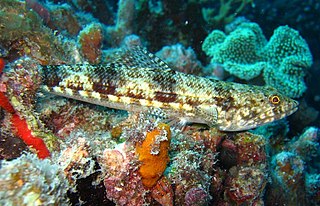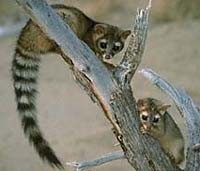
Jackals are canids native to Africa and Eurasia. While the word "jackal" has historically been used for many canines of the subtribe canina, in modern use it most commonly refers to three species: the closely related black-backed jackal and side-striped jackal of sub-Saharan Africa, and the golden jackal of south-central Europe and Asia. The African golden wolf was also formerly considered a jackal.

Felis is a genus of small and medium-sized cat species native to most of Africa and south of 60° latitude in Europe and Asia to Indochina. The genus includes the domestic cat. The smallest of the seven Felis species is the black-footed cat with a head and body length from 38 to 42 cm. The largest is the jungle cat with a head and body length from 62 to 76 cm.

The Casuarinaceae are a family of dicotyledonous flowering plants placed in the order Fagales, consisting of four genera and 91 species of trees and shrubs native to eastern Africa, Australia, Southeast Asia, Malesia, Papuasia, and the Pacific Islands. At one time, all species were placed in the genus Casuarina. Lawrence Alexander Sidney Johnson separated out many of those species and renamed them into the new genera of Gymnostoma in 1980 and 1982, Allocasuarina in 1982, and Ceuthostoma in 1988, with some additional formal descriptions of new species in each other genus. At the time, it was somewhat controversial. The monophyly of these genera was later supported in a 2003 phylogenetic study of the family. In the Wettstein system, this family was the only one placed in the order Verticillatae. Likewise, in the Engler, Cronquist, and Kubitzki systems, the Casuarinaceae were the only family placed in the order Casuarinales.

Aulopiformes is a diverse order of marine ray-finned fish consisting of some 15 extant and several prehistoric families with about 45 genera and over 230 species. The common names grinners, lizardfishes and allies, or aulopiforms are sometimes used for this group. The scientific name means "Aulopus-shaped", from Aulopus + the standard fish order suffix "-formes". It ultimately derives from Ancient Greek aulós + Latin forma, the former in reference to the elongated shape of many aulopiforms.

Bassariscus is a genus in the family Procyonidae. There are two extant species in the genus: the ringtail or ring-tailed cat and the cacomistle. Genetic studies have indicated that the closest relatives of Bassariscus are raccoons, from which they diverged about 10 million years ago in the Tortonian Age of the Miocene. The two lineages of Bassariscus are thought to have separated after only another two million years, making it the extant procyonid genus with the earliest diversification. Later diversification in the genus in the Pliocene and Pleistocene saw the emergence of two extinct species, Bassariscus casei and Bassariscus sonoitensis, respectively. Due to the more digitigrade stance of their legs compared to the plantigrade stance of other members of Procyonidae, some taxonomies place the genus as a separate family, Bassaricidae.. The name is a Greek word for fox ("bassaris") with a Latinized diminutive ending ("-iscus"). The genus was named by Elliott Coues in 1887, having previously been described by Lichtenstein in 1830 under the name Bassaris. Coues proposed the word "bassarisk" as the English term for animals in this genus. Its habitat includes semi-arid areas in the southwestern United States, the whole of Mexico, as well as moist tropical forests in Central America.

Prionailurus is a genus of spotted, small wild cats native to Asia. Forests are their preferred habitat; they feed on small mammals, reptiles and birds, and occasionally aquatic wildlife.

Juncus is a genus of monocotyledonous flowering plants, commonly known as rushes. It is the largest genus in the family Juncaceae, containing around 300 species.

The genus Bassaricyon consists of small Neotropical procyonids, popularly known as olingos, cousins of the raccoon. They are native to the rainforests of Central and South America from Nicaragua to Peru. They are arboreal and nocturnal, and live at elevations from sea level to 2,750 m (9,020 ft). Olingos closely resemble another procyonid, the kinkajou, in morphology and habits, though they lack prehensile tails and extrudable tongues, have more extended muzzles, and possess anal scent glands. However, the two genera are not sisters. They also resemble galagos and certain lemurs.

Carl Leavitt Hubbs was an American ichthyologist.
The pearleyes are a family, Scopelarchidae, of aulopiform ray-finned fish, distinguished by their unique visual system, with two retinas in each eye.
Benthalbella is a genus of pearleyes.
Scopelarchoides is a genus of pearleyes.

Scopelarchus is a genus of pearleyes.
Lagiacrusichthys macropinna, the longfin greeneye, is a species of pearleye and the only species in the genus Lagiacrusichthys. L. macropinna live between 0–840 m depth, usually 500 m. This species occurs in Antarctic waters. This species is the only known member of its genus. The genus is named after the fictional monster Lagiacrus from the Monster Hunter video game series and franchise, as both are "rather ferocious coldwater predators" that inhabit the deep ocean.
Rosenblattichthys volucris, the chubby pearleye, is a species of pearleye found in the Pacific Ocean.
Rosenblattichthys alatus, the winged pearleye, is a species of pearleye found in the tropical waters of the Indo-Pacific.
Rosenblattichthys hubbsi, also known as Hubb's pearleye, is a species of ray-finned fish in the pearleye family, Scopelarchidae. It is found worldwide.
Rosenblattichthys nemotoi is a species of ray-finned fish in the pearleye family, Scopelarchidae. It is found in the eastern Indian Ocean.
Scopelarchus analis, the short fin pearleye or blackbelly pearleye, is a species of ray-finned fish that can be found circumglobal in warm waters. It is a member of the Scopelarchus, a genus of pearleyes.
Benthalbella linguidens, the longfin pearleye, is a species of ray-finned fish that can be found in the North Pacific from Japan to California. It is a member of Benthalbella, a genus of pearleyes.









